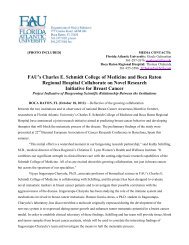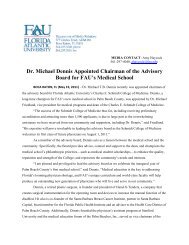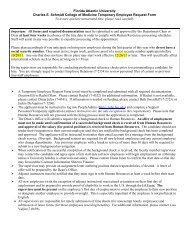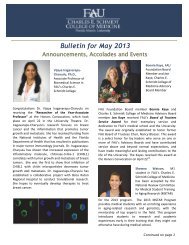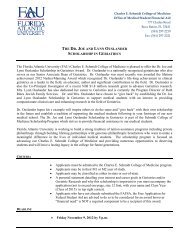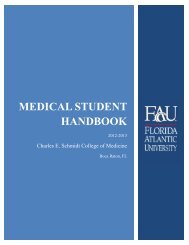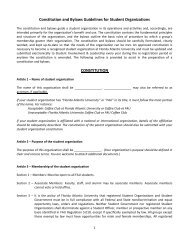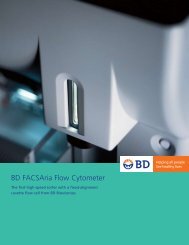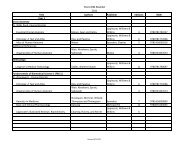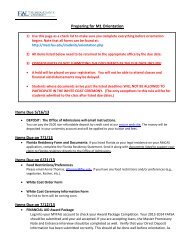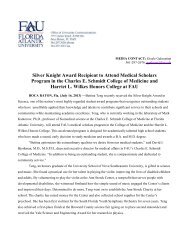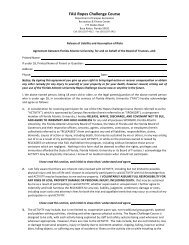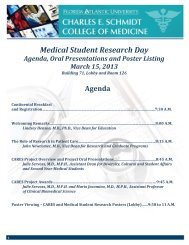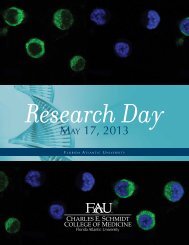Student Handbook - College of Medicine - Florida Atlantic University
Student Handbook - College of Medicine - Florida Atlantic University
Student Handbook - College of Medicine - Florida Atlantic University
You also want an ePaper? Increase the reach of your titles
YUMPU automatically turns print PDFs into web optimized ePapers that Google loves.
N L K H F E D C A<strong>Student</strong>s who are at high risk <strong>of</strong> infection from patients or other personnel because <strong>of</strong> their immune status or anyother reason are encouraged to discuss their work responsibilities and educational activities with their personal healthcare provider. If the health care provider believes that there are certain assignments the individual should not acceptdue to personal health reasons, this should be discussed with his/her faculty supervisor. In some cases, studentsmay be unable to participate fully in medical school life or meet the technical standards <strong>of</strong> the FAU <strong>College</strong> <strong>of</strong><strong>Medicine</strong> because <strong>of</strong> their disease. In these cases, the individual should contact the OSA and the FAU Office for<strong>Student</strong>s with Disabilities to discuss the existence and nature <strong>of</strong> the disability and whether reasonableaccommodations are available. For more information, see the policy on “<strong>Student</strong>s with Disabilities” contained in this<strong>Handbook</strong>. If a student’s exposure results in the contraction <strong>of</strong> a disease or disability, the student will be allowed tocontinue in the education program with as little disruption and as safely possible depending on the circumstances.The student’s specific medical circumstances will be confidentially evaluated on a case-by-case basis andappropriate recommendations regarding the student’s progress through medical school may be submitted to theMSPPSC for appropriate action, if necessary.Needlestick Injury and Other Potential Blood-borne Pathogen ExposureThe FAU <strong>College</strong> <strong>of</strong> <strong>Medicine</strong> provides a system in which all medical students, including visiting students, must reportall accidental exposures to blood and other potentially hazardous biological fluids that occur through accidentalneedlestick injury and other potential blood-borne pathogen exposure. This process is necessary for the followingreasons:to quickly evaluate the risk <strong>of</strong> infectionto inform the exposed student about treatments available to help prevent infection,to monitor for side effects <strong>of</strong> treatments, andto determine if infection subsequently occursThis process initially involves the immediate provision <strong>of</strong> appropriate first aid, including ample washing <strong>of</strong> the exposedarea that was punctured by the needle, or otherwise exposed, with soap and water. The student must immediatelycontact his/her clinical supervisor to report the incident as stated above in “Exposure at FAU” and “Exposure at a<strong>College</strong> <strong>of</strong> <strong>Medicine</strong> Affiliate Site Not Located on the Campus <strong>of</strong> FAU.” The student will need to contact the deans <strong>of</strong>the COM Office <strong>of</strong> <strong>Student</strong> Affairs and complete the FAU “Medical <strong>Student</strong> Exposure Incident Form” available on theOffice <strong>of</strong> <strong>Student</strong> Affairs webpage (http://med.fau.edu/students/). The deans <strong>of</strong> the COM Office <strong>of</strong> <strong>Student</strong> Affairsmust be notified <strong>of</strong> the exposure and the form must be submitted within 24 hours <strong>of</strong> the exposure incident. Forincidents in FAU laboratories and clinical settings owned or operated by FAU or on FAU campuses, EHS policiesmust also be followed, with EHS forms completed as described above.Subsequently, the student may require blood testing to rule out the presence <strong>of</strong> hepatitis B, hepatitis C, HIV, and/orother infectious agents in both the index patient as well as the student. The plan provides for appropriate postexposuretreatment and addresses the key aspects <strong>of</strong> OSHA Directive 29 CFR Part 1910.1030, Post-exposureEvaluation and Follow-up. https://www.osha.gov/OshDoc/data_BloodborneFacts/bbfact04.pdfAny student identified as a candidate for post-exposure HIV prophylaxis as a result <strong>of</strong> this protocol is to beimmediately referred to one <strong>of</strong> the <strong>College</strong> <strong>of</strong> <strong>Medicine</strong>’s hospital affiliates or local ambulatory care center for initiation<strong>of</strong> medications as prescribed by the medical staff. It should be noted that locating and testing the source individual iscritical for appropriate management, including immediate and follow-up testing <strong>of</strong> the student and/or source and, ifmedically indicated (e.g., HIV infection), for the student to receive prophylactic antiretroviral medication as soon aspossible, preferably within two hours <strong>of</strong> exposure.The “Selected Measures <strong>of</strong> Access to and Utilization <strong>of</strong> Treatment and Prophylaxis for HIV-infected Persons” isavailable at the Centers for Disease Control web site: http://www.cdc.gov/hiv/resources/guidelines/Workers’ CompensationGenerally, because students are not employees <strong>of</strong> the FAU <strong>College</strong> <strong>of</strong> <strong>Medicine</strong> or its clinical affiliate sites, they arenot eligible for Worker’s Compensation coverage. Therefore, any coverage for illness or injuries incurred as a medical40



